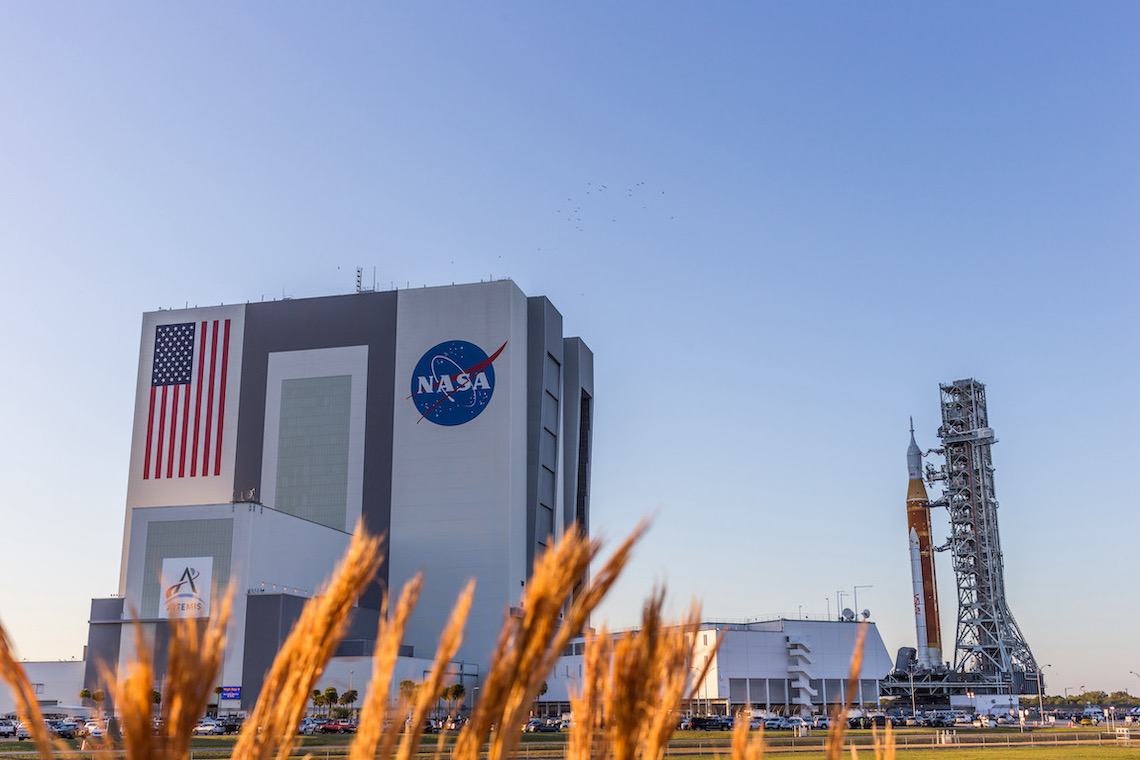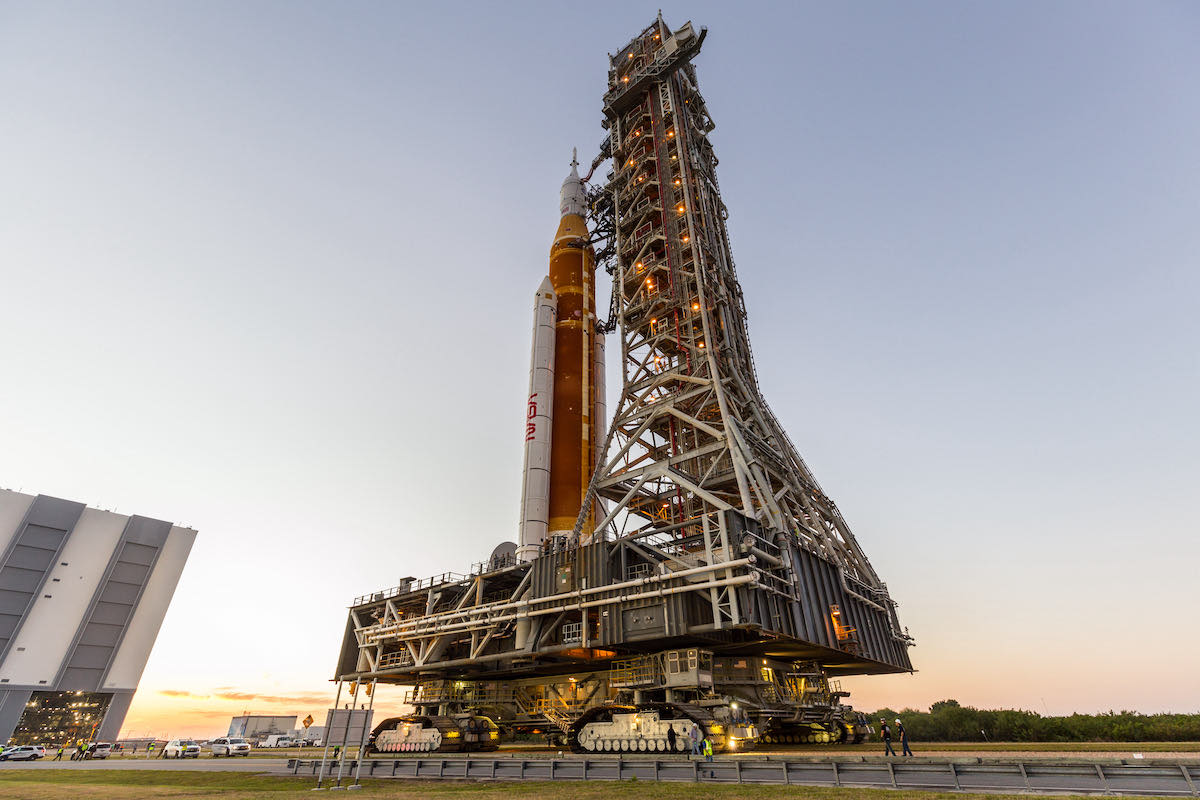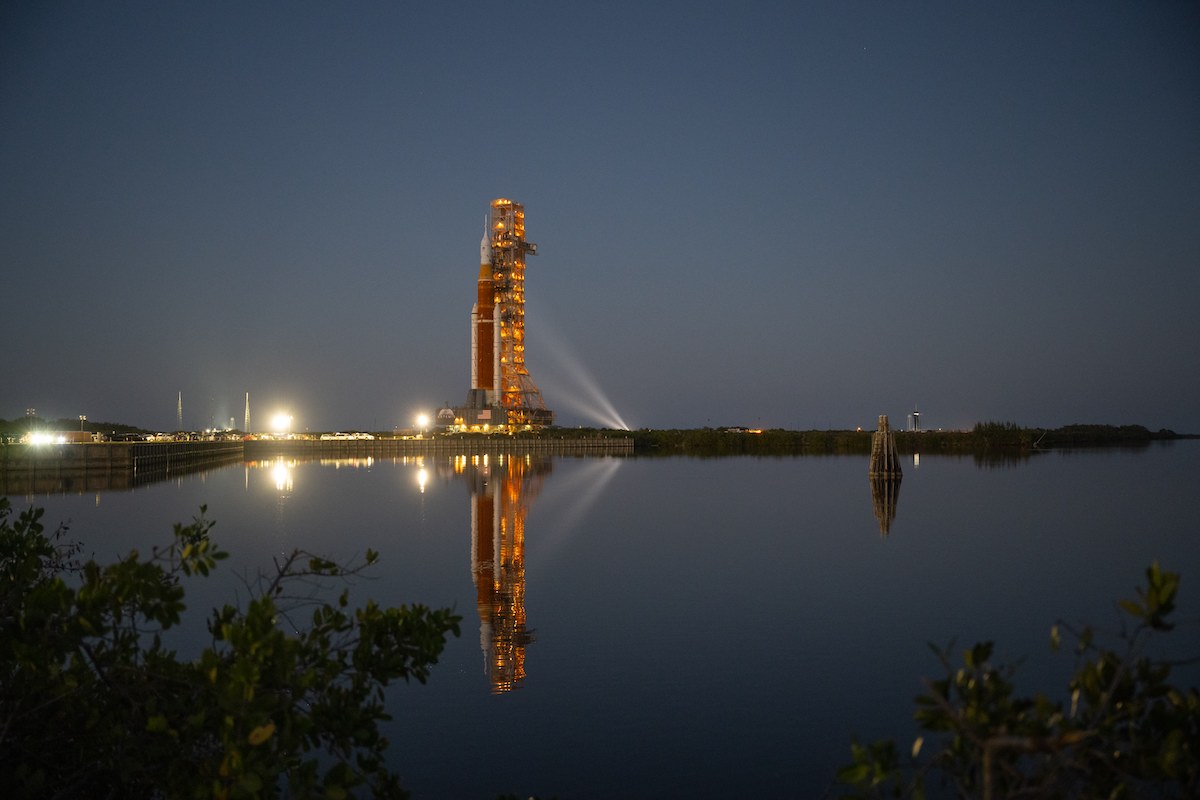Space News & Blog Articles
Photos: SLS makes its debut at NASA’s Kennedy Space Center
 Credit: Alex Polimeni / Spaceflight Now
Credit: Alex Polimeni / Spaceflight Now
The first 322-foot-tall (98-meter) Space Launch System moon rocket arrived on launch pad 39B Friday after an overnight trek from the iconic Vehicle Assembly Building at NASA’s Kennedy Space Center.
The trip aboard one of NASA’s crawler-transporters lasted more than 10 hours from the time the moon rocket began moving out of the assembly building until the mobile launch platform arrived at the deck of pad 39B, a facility originally built for the Apollo moon program, modified for the space shuttle, and now refurbished for the Space Launch System.
The SLS is the crew launch vehicle for NASA’s Artemis program, which aims to return astronauts to the surface of the moon later this decade. The Artemis 1 test flight will be the first mission of the Space Launch System, proving out the rocket and Orion crew capsule on a trip around the moon before astronauts begin riding it on the Artemis 2 flight in the 2024 timeframe.
The 4.2-mile (6.8-kilometer) journey to pad 39B began at 5:47 p.m. EDT (2147 GMT) on Thursday, March 17.
Crowds of employees, VIPs, and news media gathered outside the VAB to witness the historic rollout, marking the public debut of the Space Launch System. The rocket is the most powerful, in terms of total thrust, ever built by NASA, exceeding the Apollo-era Saturn 5 moon rocket and the space shuttle.
It’s nearly twice the height of the space shuttle in launch configuration, but about 40 feet shy of the towering Saturn 5.
The crawler stopped just outside the doors of the VAB to allow the Orion spacecraft’s crew access arm to move away from the rocket. The arm is unable to be retracted inside the high bay due to structural clearance restrictions.
Teams stopped the rollout another time to gather data on the entire stack’s response to the deceleration. The data will help inform models on the structural stiffness of the stack.
 Credit: Michael Cain / Spaceflight Now / Coldlife Photography
Credit: Michael Cain / Spaceflight Now / Coldlife Photography
The rollout then resumed and the crawler reached a top speed of around 0.8 mph before moving up the ramp to pad 39B. The crawler lowered the mobile launch platform onto pedestals at the pad around 4:15 a.m. EDT (0815 GMT) Friday.
The crawler-transporter, built in the 1960s to haul Saturn 5 rockets to the launch pad, was upgraded to handle the weight of the SLS with its mobile launch platform. The entire stack, including the crawler, mobile launch platform, and the Space Launch System, weighed around 21.4 million pounds during the rollout last week.
The rollout sets the stage for a “wet dress rehearsal” with the Space Launch System in early April, when NASA’s launch team will run the rocket through a simulated countdown and fill it with cryogenic propellants. NASA will return the rocket to the VAB later next month for more tests and checkouts ahead of a launch attempt no earlier than June.
 Credit: Michael Cain / Spaceflight Now / Coldlife Photography
Credit: Michael Cain / Spaceflight Now / Coldlife Photography
 Credit: Alex Polimeni / Spaceflight Now
Credit: Alex Polimeni / Spaceflight Now
 Credit: Michael Cain / Spaceflight Now / Coldlife Photography
Credit: Michael Cain / Spaceflight Now / Coldlife Photography
 Credit: Alex Polimeni / Spaceflight Now
Credit: Alex Polimeni / Spaceflight Now
 Credit: Alex Polimeni / Spaceflight Now
Credit: Alex Polimeni / Spaceflight Now
 Credit: Michael Cain / Spaceflight Now / Coldlife Photography
Credit: Michael Cain / Spaceflight Now / Coldlife Photography
 Credit: Alex Polimeni / Spaceflight Now
Credit: Alex Polimeni / Spaceflight Now
 Credit: Stephen Clark / Spaceflight Now
Credit: Stephen Clark / Spaceflight Now
 Credit: Alex Polimeni / Spaceflight Now
Credit: Alex Polimeni / Spaceflight Now
 Credit: Michael Cain / Spaceflight Now / Coldlife Photography
Credit: Michael Cain / Spaceflight Now / Coldlife Photography
 Credit: Alex Polimeni / Spaceflight Now
Credit: Alex Polimeni / Spaceflight Now
 Credit: Alex Polimeni / Spaceflight Now
Credit: Alex Polimeni / Spaceflight Now
 Credit: Alex Polimeni / Spaceflight Now
Credit: Alex Polimeni / Spaceflight Now
 Credit: Alex Polimeni / Spaceflight Now
Credit: Alex Polimeni / Spaceflight Now
 Credit: Michael Cain / Spaceflight Now / Coldlife Photography
Credit: Michael Cain / Spaceflight Now / Coldlife Photography
 Credit: Alex Polimeni / Spaceflight Now
Credit: Alex Polimeni / Spaceflight Now
 Credit: Alex Polimeni / Spaceflight Now
Credit: Alex Polimeni / Spaceflight Now
 Credit: Alex Polimeni / Spaceflight Now
Credit: Alex Polimeni / Spaceflight Now
 Credit: Alex Polimeni / Spaceflight Now
Credit: Alex Polimeni / Spaceflight Now
This email address is being protected from spambots. You need JavaScript enabled to view it. the author.
Follow Stephen Clark on Twitter: @StephenClark1.
When you subscribe to the SpaceZE News Feed, we will send you an e-mail when there are new updates on the site so you wouldn't miss them.

